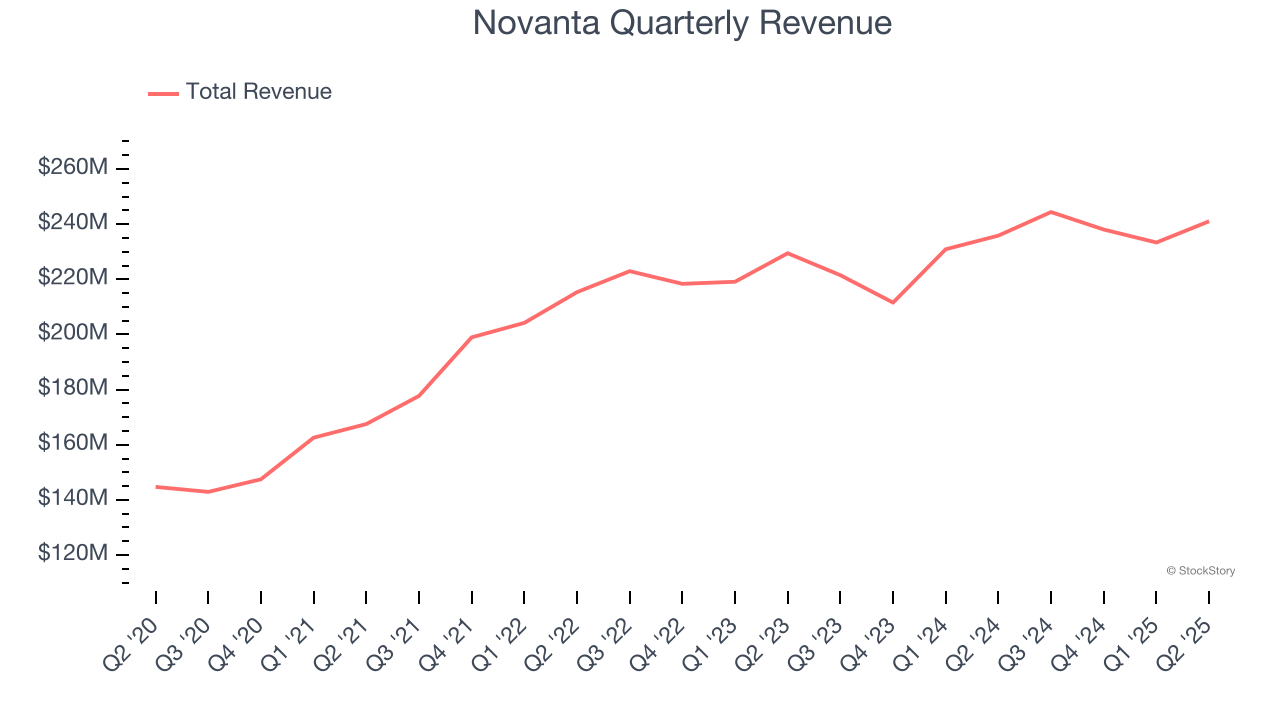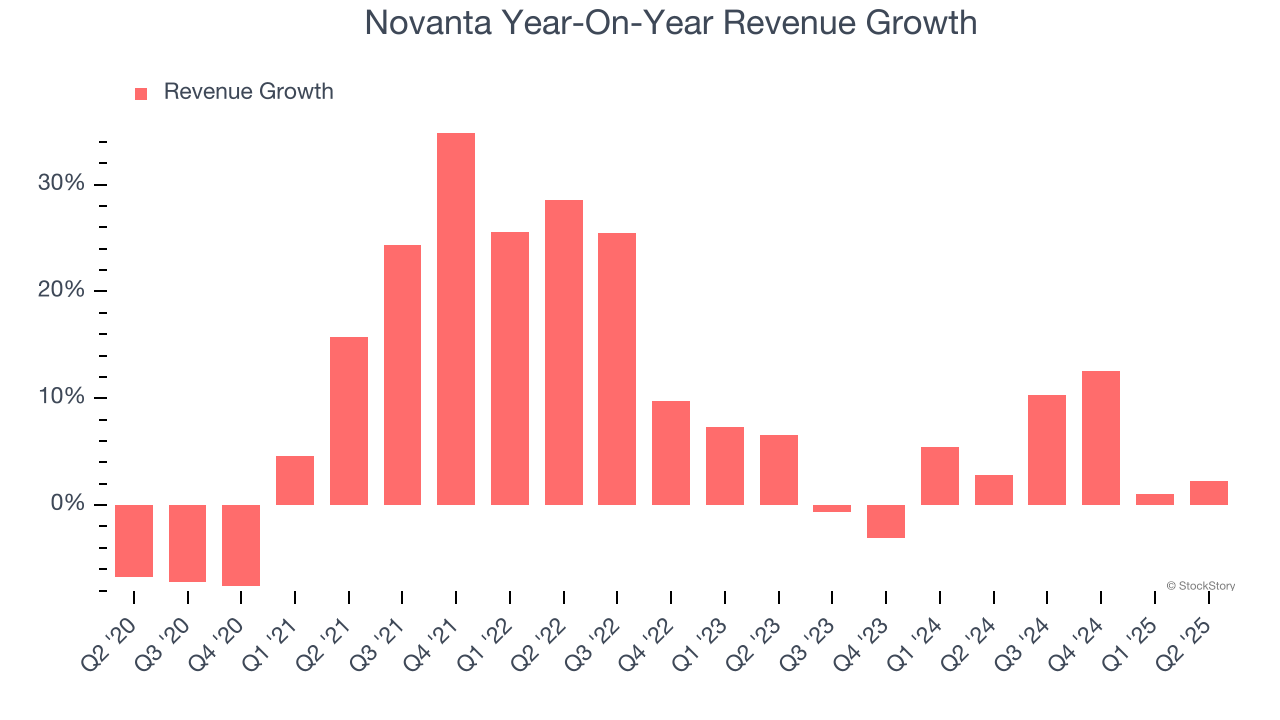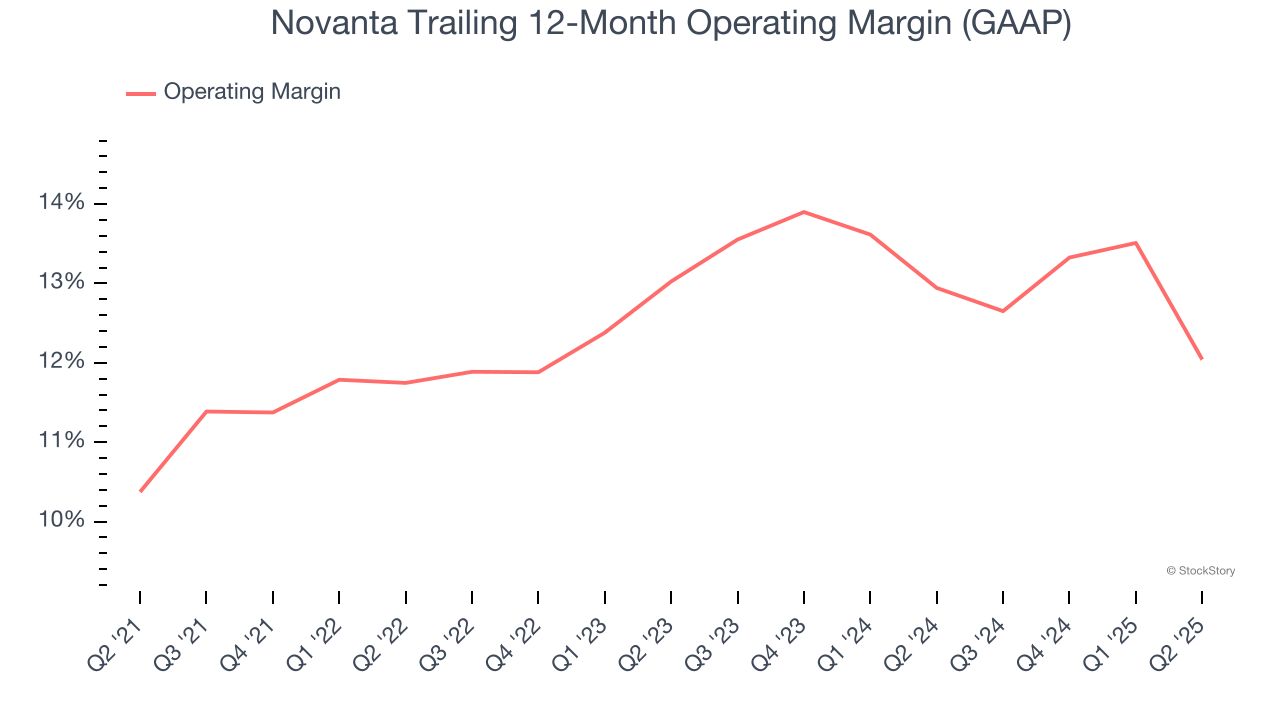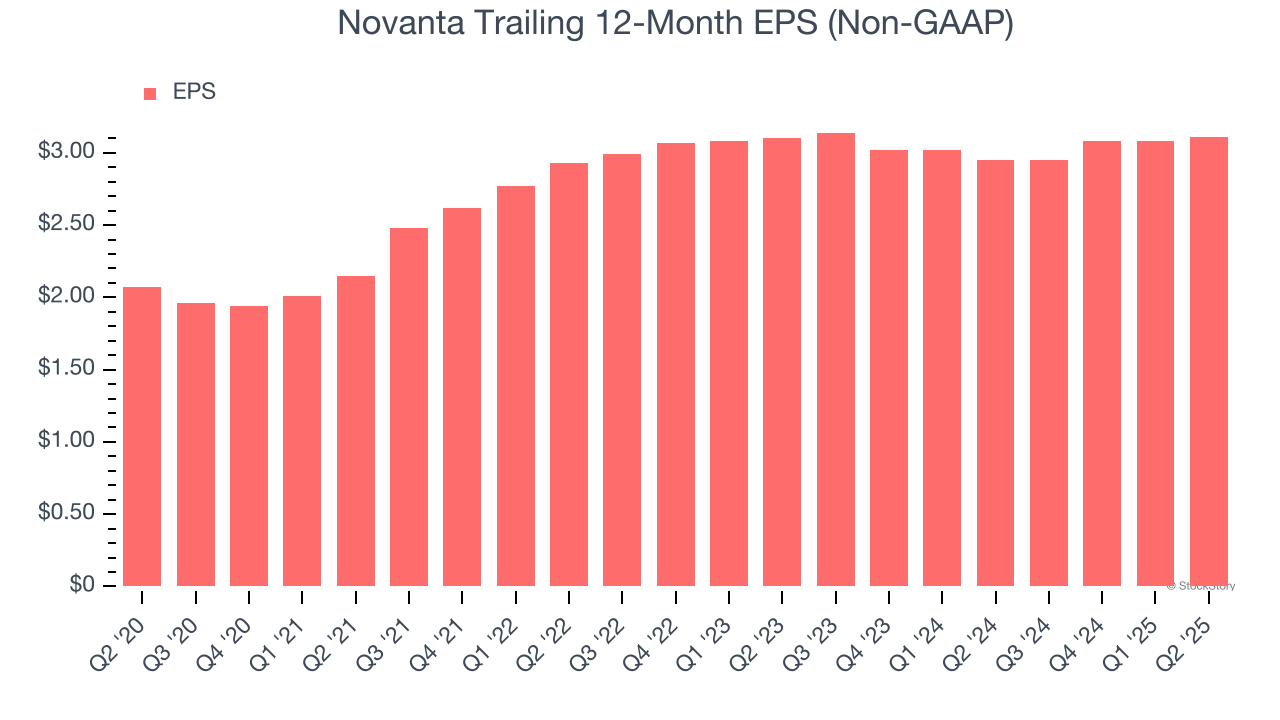
Medicine and manufacturing technology provider Novanta (NASDAQ:NOVT) announced better-than-expected revenue in Q2 CY2025, with sales up 2.2% year on year to $241 million. On the other hand, next quarter’s revenue guidance of $245.5 million was less impressive, coming in 3.6% below analysts’ estimates. Its non-GAAP profit of $0.76 per share was 3.6% above analysts’ consensus estimates.
Is now the time to buy Novanta? Find out by accessing our full research report, it’s free.
Novanta (NOVT) Q2 CY2025 Highlights:
- Revenue: $241 million vs analyst estimates of $238 million (2.2% year-on-year growth, 1.3% beat)
- Adjusted EPS: $0.76 vs analyst estimates of $0.73 (3.6% beat)
- Adjusted EBITDA: $52.16 million vs analyst estimates of $51.49 million (21.6% margin, 1.3% beat)
- Revenue Guidance for the full year is $977.5 million at the midpoint, below analyst estimates of $983.2 million
- Adjusted EPS guidance for the full year is $3.29 at the midpoint, missing analyst estimates by 2.4%
- EBITDA guidance for the full year is $227.5 million at the midpoint, below analyst estimates of $231.5 million
- Operating Margin: 6.2%, down from 12% in the same quarter last year
- Free Cash Flow Margin: 4.8%, down from 15.3% in the same quarter last year
- Market Capitalization: $4.46 billion
“Novanta delivered solid second quarter financial results, meeting or exceeding expectations in revenue, margins, and profitability, while rapidly adapting to the ongoing challenging macroeconomic environment,” said Matthijs Glastra, Chair and Chief Executive Officer of Novanta.
Company Overview
Originally a pioneer in the laser scanning industry during the late 1960s, Novanta (NASDAQ:NOVT) offers medicine and manufacturing technology to the medical, life sciences, and manufacturing industries.
Revenue Growth
Examining a company’s long-term performance can provide clues about its quality. Any business can have short-term success, but a top-tier one grows for years. Thankfully, Novanta’s 9.3% annualized revenue growth over the last five years was solid. Its growth beat the average industrials company and shows its offerings resonate with customers.

Long-term growth is the most important, but within industrials, a half-decade historical view may miss new industry trends or demand cycles. Novanta’s recent performance shows its demand has slowed as its annualized revenue growth of 3.7% over the last two years was below its five-year trend. We also note many other Electronic Components businesses have faced declining sales because of cyclical headwinds. While Novanta grew slower than we’d like, it did do better than its peers. 
This quarter, Novanta reported modest year-on-year revenue growth of 2.2% but beat Wall Street’s estimates by 1.3%. Company management is currently guiding for flat sales next quarter.
Looking further ahead, sell-side analysts expect revenue to grow 6.1% over the next 12 months. Although this projection indicates its newer products and services will catalyze better top-line performance, it is still below average for the sector.
Here at StockStory, we certainly understand the potential of thematic investing. Diverse winners from Microsoft (MSFT) to Alphabet (GOOG), Coca-Cola (KO) to Monster Beverage (MNST) could all have been identified as promising growth stories with a megatrend driving the growth. So, in that spirit, we’ve identified a relatively under-the-radar profitable growth stock benefiting from the rise of AI, available to you FREE via this link.
Operating Margin
Novanta has been an efficient company over the last five years. It was one of the more profitable businesses in the industrials sector, boasting an average operating margin of 12.1%. This result isn’t surprising as its high gross margin gives it a favorable starting point.
Looking at the trend in its profitability, Novanta’s operating margin rose by 1.7 percentage points over the last five years, as its sales growth gave it operating leverage.

This quarter, Novanta generated an operating margin profit margin of 6.2%, down 5.8 percentage points year on year. Since Novanta’s operating margin decreased more than its gross margin, we can assume it was less efficient because expenses such as marketing, R&D, and administrative overhead increased.
Earnings Per Share
Revenue trends explain a company’s historical growth, but the long-term change in earnings per share (EPS) points to the profitability of that growth – for example, a company could inflate its sales through excessive spending on advertising and promotions.
Novanta’s decent 8.5% annual EPS growth over the last five years aligns with its revenue performance. This tells us its incremental sales were profitable.

Like with revenue, we analyze EPS over a shorter period to see if we are missing a change in the business.
Novanta’s flat two-year EPS was subpar and lower than its 3.7% two-year revenue growth.
Diving into the nuances of Novanta’s earnings can give us a better understanding of its performance. Novanta’s operating margin has declined by 8.4 percentage points over the last two years. This was the most relevant factor (aside from the revenue impact) behind its lower earnings; interest expenses and taxes can also affect EPS but don’t tell us as much about a company’s fundamentals.
In Q2, Novanta reported adjusted EPS at $0.76, up from $0.73 in the same quarter last year. This print beat analysts’ estimates by 3.6%. We also like to analyze expected EPS growth based on Wall Street analysts’ consensus projections, but there is insufficient data.
Key Takeaways from Novanta’s Q2 Results
It was good to see Novanta narrowly top analysts’ revenue expectations this quarter. We were also happy its EBITDA narrowly outperformed Wall Street’s estimates. On the other hand, its EBITDA guidance for next quarter missed and its revenue guidance for next quarter fell short of Wall Street’s estimates. Overall, this was a softer quarter. The stock remained flat at $124.01 immediately after reporting.
Novanta may have had a tough quarter, but does that actually create an opportunity to invest right now? What happened in the latest quarter matters, but not as much as longer-term business quality and valuation, when deciding whether to invest in this stock. We cover that in our actionable full research report which you can read here, it’s free.
